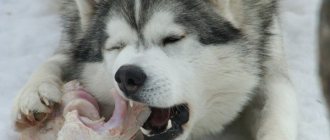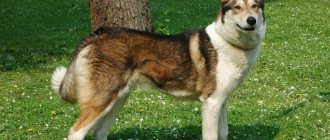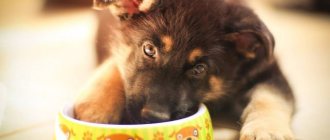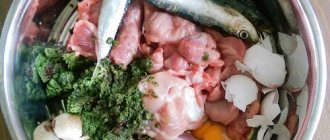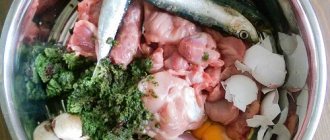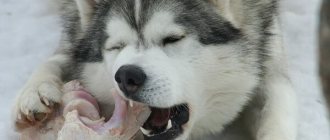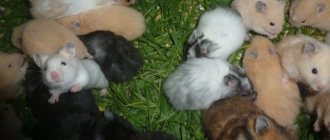The type of dog called retrievers combines six breeds. Among them there are very Popular breeds: golden retriever and labrador.
These animals are born hunters . They have an excellent sense of smell, a soft jaw and an easy-going nature. When hunting, they work in tandem with a cop: while the first detects the game, the second brings the shot prey to the owner without biting it.
In modern urban conditions, Labradors are kept at home not as hunter's assistants, but as pets. These are very kind dogs that love to play with children and can be just a good friend to anyone.
A feature of the breed is its tendency to gluttony - they are ready to eat any amount of food. This dog breed is also prone to obesity. Therefore, Labradors need long walks (in parks, squares, in the forest) and active games.
One of the most important elements of keeping any pet, especially such a large one, is nutrition .
To the question, what is the best food to feed a Labrador? The answer is clear - meat is the basis of any dog’s diet.
Important! Your Labrador needs to be fed regularly and at the same time. This will ensure balanced development along with the immediate composition of food.
Ready-made food for Labrador puppies
The diet of many young Labrador retrievers consists of commercial dry and wet food. And the choice of their owners is justified: such products are balanced, healthy, nothing needs to be prepared, dry industrial food does not spoil for a long time, and wet food is available in portioned bags or jars. True, the price of high-quality canned puppy food and dry food is steep.
If the choice is still made in favor of industrial products, then what food should you feed your Labrador puppy? highly recommend giving preference to extra premium food
, the main component of which is a high-quality source of protein - natural meat and fish. The composition of such products, which are best absorbed by the dog’s body, contains at least 60-70% meat, while in premium level products there is about 35-20% meat, and in cheap economy class food there is often no meat (more precisely, meat ingredients of dubious quality). more than 10-5%.
So what brand of food is best for a small Labrador? We advise you to pay attention to such high-quality products (it is important to take into account that the packaging must certainly contain marks that the food is specifically for puppies: “Puppy”, “Baby”, “Junior”, etc., since food for adult dogs is for young not suitable for dogs):
- MONGE;
- ACANA;
- Orijen;
- GRANDORF;
- Brit Care;
- Bosch;
- EUKANUBA.
During pregnancy and after childbirth
A pregnant dog needs special care and proper nutrition. The balance of necessary substances is very important, so it is better to feed your Labrador with specialized dry food. In the first half of pregnancy, the diet is left unchanged. During the first 6 weeks, the portion is increased by no more than 10%. A month before giving birth, it increases by 20-25%.
A pregnant Labrador needs about 17% fat and 29% protein. If the expectant mother eats natural food, she will need a complex of vitamin supplements.
After giving birth, the dog switches to enhanced nutrition. She should not be limited in food. She can eat 3 times more than usual.
A properly selected diet is the key to a Labrador’s longevity. A good owner will not skimp on the pet’s food and will take care of a full menu.
If the choice fell on a natural diet
Many veterinarians and experienced breeders believe that it is correct to feed a Labrador puppy those dishes that were prepared by the owner himself from products that are not in doubt. This does not mean those dishes that are prepared for the whole family (borscht, cutlets, navy pasta, etc.), but what is prepared specifically for the dog, taking into account all its needs.
As a rule, the puppy actively suckles at the mother's breast until 2-3 weeks; around this time, the first complementary foods are introduced in the form of a small amount of boiled meat, turned into puree. And already from 1-1.5 months, puppies begin to eat almost the same as adult dogs. The menu for a Labrador puppy aged 1 to 3 months should include a lot of dairy products - about 50% of the total food (this includes milk, cottage cheese, and fermented milk products). Approximately 20% of food should be meat (including offal, fish), 15% each should be cereals and vegetables.
From the moment the puppy turns 3-4 months old, the situation with the amount of dairy products in the diet changes slightly. At this age, the animal requires more meat - at least 50% of the total food volume, but the share of milk dishes decreases to 20%, vegetables and cereals still account for 15%.
Rules of care
The daily routine of puppies at the age of 1 month is quite monotonous. They eat, relieve themselves, sleep, and play.
The puppy's place should be equipped taking into account these needs. You need a bed (bedding), a diaper, bowls for food and water, toys. There is no need to wash the puppy frequently unless necessary; this leads to degreasing of the coat, dry skin, and dandruff.
For the safety and convenience of keeping your puppy, you can purchase a cage or enclosure. This keeps the apartment furnishings intact, makes toilet training easier, and the dogs perceive the crate as their place.
At 30 days, you need to start accustoming the puppy to a collar, toilet and diaper, you can start training (accustoming to a nickname, simple commands), teach behavior - in the house and with people.
All communication with a puppy at this age should be positive, without punishment. Often Labradors at this age bite their owners while playing - you need to carefully, without harshness, wean the puppy away from this - switch attention to the toy, ignore playing with the dog until it stops. When bitten, trainers advise sharply screaming and stopping the game to create a stable connection in the puppy - “bite-cry-end of the game.”
Teething causes itching, which puppies relieve by chewing. If you do not provide them with special toys and treats during this period, they may chew furniture, shoes, things and objects.
Once every 7-10 days you need to trim the puppy’s nails . It is more convenient to do this with a special nail clipper, which can be bought at a pet store. Be careful - you can only cut off the overgrown part of the claw, so as not to touch or damage the blood vessel.
What foods should be in a puppy's diet?
Now let's talk about what to feed a Labrador puppy. We list the main products that can almost always be given to your baby (if, of course, there is no allergy to a particular product):
- Lean meat
(veal, turkey or chicken, rabbit). Most often, puppies are given boiled meat, but if you feed the animal raw meat, then it must be kept in the freezer for a week (at least 3 days) to destroy helminths. At an early age (at 1-2 months), it is advisable to give meat in highly chopped form; - Offal
– beef trachea, tripe, cartilage, heart, lungs, some liver. They are boiled and crushed, and then mixed with cereals or vegetables; - Sea fish
(cod, chum salmon, salmon, etc.). It is also given boiled without bones; - Dairy products
are fresh and low-fat (puppies up to 3-4 months old have porridge cooked in milk, and older dogs are usually given sour milk); - Cereals
– rice, buckwheat, oatmeal. They are cooked in the usual way using water, meat broth or milk, but without adding any sugar, butter or salt. As a rule, porridge for puppies is mixed with pieces of meat, fish or offal; - Vegetables
- pumpkin, zucchini, carrots, cauliflower, turnips, bell peppers. As a rule, vegetables are briefly boiled and chopped before serving to the dog. You can also give your puppy raw vegetables, chopped with a knife or grated, but only if there is no diarrhea. Not all dogs are delighted with vegetables, so they are usually added in small quantities to porridge or meat; - Greens
– parsley, dill, lettuce. The greens are finely chopped and added to dishes prepared for the puppy; - Vegetable oils
– flaxseed, sunflower, olive. They are added in small quantities (0.5-1 tbsp) to ready-made dishes; - Eggs
- quail or chicken. They are given to puppies once a week, 2-1 pcs. respectively.
Natural nutrition
Natural feeding involves preparing food for your puppy at home. This approach to feeding allows the owner to independently choose the products on which the menu will be based, control their quality and freshness, and provide the pet with the most varied diet.
Advantages and disadvantages
In addition to a varied menu, which eliminates the possibility that the puppy will get bored with food, the natural type of food has a number of undeniable advantages:
- the food contains no preservatives, chemical flavors, dyes or flavor enhancers;
- if one of the products in the diet causes an allergy or indigestion in the puppy, choosing an analogue without making other changes to the menu will not be a problem;
- beneficial substances obtained from natural products are almost completely absorbed by the puppy’s body.
NOTE! In winter, puppies need more natural food than in summer, and with increased physical activity, the content of animal protein in the diet should be increased.
Disadvantages of natural feeding:
- cooking food requires a lot of time;
- inconvenience when traveling and moving;
- short shelf life, which necessitates daily cooking.
Preparing a balanced diet requires certain knowledge; inexperienced dog breeders may need the help of a qualified veterinarian who can create a competent menu for a puppy.
An incorrectly formulated diet can lead to an imbalance that provokes vitamin deficiency, hypervitaminosis, rickets and other health problems.
Authorized Products
Nutrition is one of the main elements of healthy dog development. When composing a puppy’s diet, it is necessary to remember that it should be based on animal protein.
What can you feed a Labrador puppy?
To provide your puppy with all the necessary nutrients, macro- and microelements, you must include in his diet:
- lean meat - beef, chicken, turkey, rabbit;
- tendons and veins;
- offal - trachea, cheeks, liver, spleen, unpeeled stomachs;
- cereals – oatmeal, buckwheat, rice;
- puree of greens, vegetables, fruits - carrots, pumpkin, cauliflower, beets, zucchini, turnips, apples, pears, apricots, spinach, lettuce, onions;
- vegetable oils, but not more than 1 tsp. in a day;
- low-fat fermented milk products – cottage cheese, fermented baked milk, kefir, yoghurts;
- eggs maximum twice a week;
- marine fish varieties - hake, pollock.
Once every 1-2 weeks, it is permissible to give the puppy a finely chopped clove of garlic - it acts as a natural anthelmintic and an additional source of vitamins.
As the first complementary food when weaning a puppy, it is best to give cottage cheese, bifidok, yogurt, liquid cereals, chopped boiled meat - chicken or turkey.
An additional source of calcium is eggshells, crushed into powder, which should be added to milk or cereal.
Absolutely forbidden
Labradors are not picky eaters and will eat with equal pleasure anything that is offered to them or that they find on their own.
At the same time, it is important to understand that not all products are useful for representatives of this breed, and some pose a direct threat to the health and harmonious development of the puppy
You cannot feed your pet:
- chocolate – it overstimulates the heart, negatively affects the liver, and provokes an allergic reaction;
- sugar and sweets - they provoke obesity and lead to tooth damage;
- fatty foods that negatively affect the liver of animals;
- tubular and bird bones, since they can cause constipation, obstruction and intestinal perforation;
- spices, spices - hot seasonings burn the gastrointestinal mucosa, lead to stomach ulcers, and reduce the acuity of smell;
- onions - can lead to acute poisoning;
- vinegar – provoke peptic ulcer;
- pasta - lead to fermentation in the stomach and intestines.
In addition, the list of foods prohibited for Labrador puppies includes:
- potato;
- legumes;
- corn;
- bakery products;
- broccoli;
- mushrooms;
- nutmeg;
- grapes, currants, citrus fruits, raisins.
Puppies 4 months of age and older should not be given cow's milk as it is not digestible and can cause digestive problems.
IMPORTANT! It is forbidden to feed puppies with food from the common table.
What foods should you not give to Labradors?
The following foods should not be included in your Labrador puppy's diet:
- Fat meat;
- Bones (sometimes large femur bones can be given to puppies as a toy to massage the gums, but only under the supervision of the owner);
- River fish and small sea fish like sprat;
- Some plant products (potatoes, corn, beets, onions and garlic, any mushrooms, tomatoes, legumes, a lot of white cabbage, citrus fruits and any other overseas berries and fruits, grapes, nuts);
- Fresh bakery;
- Sugar, chocolate and other sweets (marmalade, marshmallows, toffee, etc.);
- Alcohol and fizzy drinks;
- Sausages, regardless of type;
- Sauces;
- Spices and salt;
- Any fried and smoked foods.
Reproduction
The first thing you must understand and learn: only breeding representatives of the breed can participate in breeding, in accordance with the breeding plan drawn up in the kennel club. If you have purchased a pet-class dog, it is better to sterilize it immediately
The common belief that a dog needs to be mated at least once in its life “for health” is a harmful myth. Having untied the male, you will have to provide him with regular matings, and this is reasonable only if the male is good enough in terms of breed. A castrated male does not suffer at all from the absence of testicles; he retains a lively and energetic character and mobility. But he does not suffer from hormonal storms when a female dog in heat appears in the area, is free from the associated stress and lives longer. Males are sterilized after reaching physiological maturity.
A spayed female dog is guaranteed not to breed accidentally and will also not develop pyometra or ovarian cancer. The absence of heat will make the dog calmer and your apartment cleaner, since the heat of this breed can be quite abundant and leaves marks throughout the house. Sterilization, like mating in Labradors, occurs after 2 years, when the dog’s body is already fully formed.
If your bitch belongs to the breeding class, and you intend to breed her in order to produce puppies, then be prepared for the subsequent renovation of the apartment. Labrador retrievers usually give birth to 5 to 10 puppies, and these little terminators can turn the most well-kept apartment into something completely obscene.
The first heat in Labrador bitches occurs at the age of 8 months to one and a half years, but mating is carried out only at 2-4 heats. During this time, you will already have time to decide whether to breed or sterilize the dog.
What is important to consider when feeding a puppy
So, we figured out what to feed a Labrador puppy at home. Now let’s find out what daily feeding rules it is important not to forget about:
- You should not force your baby Labrador to eat something that he absolutely does not like
. Yelling and pushing towards the bowl is simply unacceptable. It is much better to replace an unloved product with something of equal value (for example, dairy and meat products compensate for the absence of fish on the menu); - Your Labrador should be fed at approximately the same time every day.
; - There is no need to feed the puppy abundantly unscheduled, even if he really asks for it
. All Labradors are susceptible to obesity, so overfeeding at an early age is undesirable. If your pet begs for something tasty, you can treat him with homemade liver treats or dried meat (offal). Another option is a purchased tendon bone; - Uneaten food should not be present in the puppy’s bowl all the time
(we are talking about a natural puppy). You should set aside about 15 minutes for each meal. If the dog does not finish the entire portion at once, the food can be hidden in the refrigerator to be given later; - If the owner, due to being busy, does not have the opportunity to feed the puppy by the hour
, there is only one way out - you need to leave dry food in the bowl, which does not spoil for a long time. The remaining wet food will have to be put into the refrigerator after each feeding; - Fresh water should always be present in the bowl
. The water needs to be changed at least once a day; - It is important to pay attention to the cleanliness of your animal's bowls
; - Puppy food should always be at room temperature.
; - You should not feed your Labrador with either prepared food or natural food
. In the future, this will negatively affect the animal’s digestion; - Within 1-1.5 hours after eating, you should not overload the puppy with physical tasks
, including active games; - You should never give your Labrador Retriever puppy any products of questionable quality
(this applies to both store-bought food and dishes prepared by the owner).
Feeding problems
Labradors are big eaters. They are not capricious, not picky about food, and will never refuse a supplement. Because of this, dogs of this breed are overly fat and require a low-carbohydrate, low-protein diet. But sometimes the puppy stops coming to his favorite bowl, doesn’t answer the call, and refuses to eat. He looks for a secluded place, lays down there, looks sad.
Reasons for refusing to eat
There are psychological reasons for refusing food. Usually the problem is solved quickly and goes away after the irritating factor is eliminated.
Why doesn't the puppy eat:
- changing food or switching to a different type of food;
- separation from mother and dog family;
- stress, fear;
- hot weather;
- staleness of food.
Repeated refusal to feed is a signal of a possible illness.
How much food to give a Labrador puppy
We have already mentioned above that Labrador retrievers are still lovers of food, but you cannot overfeed them. How not to make a mistake with portion sizes? With ready-made food, everything is clear: all feeding recommendations (including the weight of portions) are written on the packaging.
With natural food it’s a little more complicated. The weight of all the food that a baby eats per day should not exceed 7-9% of his weight. Let's take, for example, a 4-month-old Labrador weighing 20 kg. He needs to eat about 1.4-1.8 kg of food per day, that is, each portion (and there are 4 of them per day at this age) should weigh 350-450 g. And a 1.5-month-old puppy weighing 5 kg requires there is much less food: from 350 to 450 g per day (i.e., one serving of food should weigh approximately 60-75 g).
Please note that these figures are approximate. So you shouldn’t worry if your dog suddenly eats less than normal or asks for more, licking the bowl clean. Portions can be slightly increased or decreased within reasonable limits.
How often should you feed an adult retriever?
An adult dog is fed twice a day. Morning and evening portions should be approximately equal in volume.
Ideally, you should feed at the same time. Like any living creature, a dog must eat regularly. If the animal refuses to eat for 24-36 hours (2-3 meals), then urgently take the Labrador to the veterinarian.
It is worth paying attention to other symptoms that indicate that the animal has problems: refusal of water, vomiting, diarrhea, foam at the mouth, lethargy, snot, constipation, fever, causeless pain. It is quite possible for anyone who owns this dog to raise a Labrador strong and strong.
It is quite possible for anyone who gets this dog to raise a Labrador strong and strong.
The main thing is to pay attention to your pet’s food and its ratio. If you have questions, veterinarians will provide all the necessary information about feeding the retriever.
https://vashkinolog.com/porody/bolshie/labrador/chem-kormit-retrivera.html
https://dogipedia.ru/chem-kormit-labradora/
Utensils for food
All dishes for the dog should have smooth edges so as not to cut the tongue. Buy stainless steel bowls. Mount them on a bracket that you can purchase at a pet store. This tripod allows you to raise the bowl to the level of the dog’s elbow joints. This allows your Labrador to develop good posture.
15 minutes after eating, remove the bowl and wash it. This will teach the dog to routine and discipline.
Required Supplements
Even natural feeding does not always provide the growing body with the necessary vitamins and minerals. Currently, there are good vitamin complexes on the market that include essential vitamins.
- Gelakan Baby. This vitamin supplement contains: collagen, phosphorus, calcium, magnesium, vitamin C. The supplement strengthens joints and promotes the proper formation of bones and the puppy’s musculoskeletal system. Gelacan can be added to food starting from 2 months of age.
- Irish Kal. A Dutch preparation that contains: proteins, fats, carbohydrates, phosphorus, magnesium, vitamins B1, B2, B6. The supplement promotes the formation of a healthy musculoskeletal system, strong teeth, healthy coat; normalizes the digestibility of food and the puppy’s metabolism. Maintains excellent health. Recommended for puppies from 4 months.
- Calcidee . This is a mineral and vitamin supplement that can be taken with food every day. The composition includes calcium, phosphorus, vitamin D3. Helps form and maintain healthy bones, teeth, claws. It is recommended for puppies from 2 months of age to take one tablet per day.
- Glucosamine with chondroitin. This drug perfectly supports the health of cartilage tissue and joints. It can also be consumed when your puppy is injured for faster healing. Recommended for puppies from three months.
